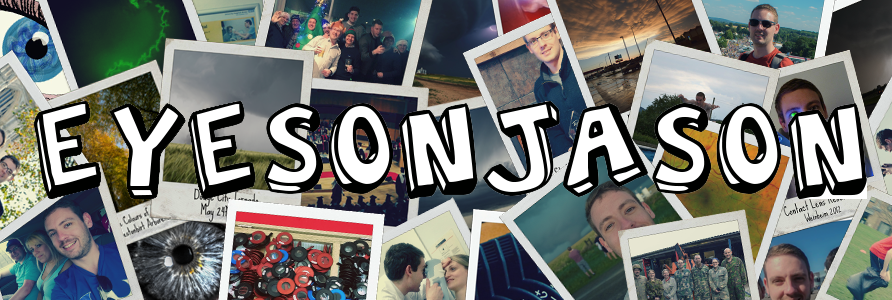Introduction
Self motion is the motion caused by the body, head or eye movements. Optic flow is the visual perception of movement through a visual scene. This chapter will look at each of these visual processes, how they occur and why they are important.
Optic Flow (Top)
Gibson (1950, 1979) was an environmentalist that took a different approach to vision. This environmental approach to vision took consideration of the whole visual scene rather than looking at individual, isolated objects within the visual scene.
This lead to the idea of the optic array, which is the pattern of light reaching a point in space from all the possible directions. The intensity and spatial pattern of light differs according to the surface from which it is reflected. An example of an optic array is the retinal image.
As an observer moves through the world, there is a gradual shift in the optic array around them. An example of this is walking down the street and the optic array (the street environment around them) flows past the observer on both sides. This movement is called optic flow. The pattern of optic flow can be seen in the figure to the right.
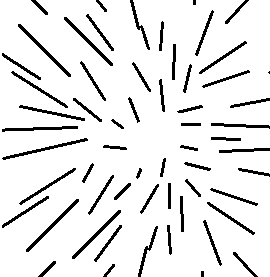
Optic array flows out from the centre when walking forward in an environment
Optic flow is caused by the relative movement between the observer and the environment. The origin of the optic flow (the point at where optic flow is absent and seems to come from) is known as the focus of expansion. This focus of expansion is focused upon the observer's destination and the optic flow will always be travelling in a direction away from the focus of expansion.
The scene in the figure on the left shows a lengthy road tunnel travelling along a strip of land near the coast. Tunnels can provide a good way to explain optic flow as there are points that expand as you move towards them.
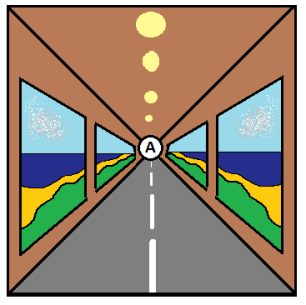
A tunnel scene often helps to explain optic flow
The focus of expansion here is found at A, and this is the observer's destination following their movement. As the observer continues to move towards the focus of expansion, the optic array expands from this point and the scene will continue to expand until the observer stops. The scene will reach the edge of the observer's visual field and disappear beyond it.
The speed at which the optic flow occurs depends on three things:
Speed of observer's movement.
The optic flow will increase if the observer moves faster and they will perceive faster movement.
Distance from focus of expansion.
Optic flow is at its greatest speed when further away from the focus of expansion. This can be experienced when near objects rapidly fly out of our field of view in the periphery and objects closer to the focus of expansion (in the distance) stay in the field of view for longer.
The layout of the 3D surfaces.
This is illustrated in the figure below, where it can be seen that objects closer to the observer have a faster optic flow than those in the distance. Looking through a train window, the shrubs and foreground seem to travel by extremely quickly but the mountains in the distance stay within view for a prolonged period of time. Therefore the closer an object is to the observer, the faster its optic flow during movement
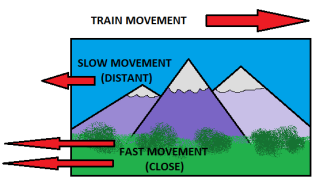
Optic flow speeds when looking out a train window
When the observer is moving in a straight line (translational movement), they have a constant view of the focus of expansion and this provides information about the destination of the observer's movement. Images of objects expand radially into the periphery as we move towards them, with the rate of expansion being fastest when farthest away from the focus of expansion, aiding in calculating the proximity of the object.
Furthermore, a closer surface will provide a faster flow pattern and thus give the observer more information about a 3D shape and edges. Any discontinuity in speed will provide information on the edges at different distances. Smooth changes in speed will help ascertain the sides of 3D shapes.
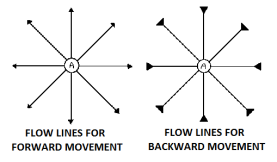
Direction of flow indicates forwards or backwards motion
The direction of the flow also provides information regarding the direction of the observers movement (see figure above). If the observer is moving forward then the optic flow radiates outwards from the focus of expansion and off into the periphery. If the observer is moving backwards, then the flow lines radiate from the periphery and towards the focus of contraction.
This gets a bit more complicated when the observer moves in a curved line as the optic flow will now have a translational and a rotational movement combined. Therefore the brain needs to be able to separate the translational movement from the rotational movement as it is the translational movement that provides it information about speed, direction and destination.
Therefore the brain needs to consider retinal flow:
Evidence for Flow-Specific Mechanisms (Top)
There are several pieces of evidence that this occurs:
Neurophysiological Evidence
The areas of MT and MST contain cells sensitive to large field unidirectional motion. These cells allow us to use the optic flow to determine the direction of our movement. MST contains larger receptive fields, possibly due to the combination of several inputs of MT cells. Area MST also has cells which respond to expansions, contractions and rotations (which help with translational and rotational optic flow).
Psychophysical Evidence
It is believed that the human visual system has specialised in expansion-selective mechanisms, as there is evidence that adaptation to these mechanisms (such as in the belladonna effect). However, despite this, there is a current lack of complete evidence for the rotational specific mechanism.
Eye and Head Movements (Top)
When a person moves their eyes or turn their head to track a moving object, there is no motion of the moving object image on the retina (i.e. the object is being tracked by the fovea and thus remains on the fovea, with only the head and eyes moving). Despite this lack of movement of the retinal image, the perception is still that of the object moving. On the other side to this, a person can move their eyes or head around a visual scene and stationary objects are not seen to be moving, even though their image shifts across the retina.
This means that the human visual system has the ability to distinguish between self motion and externally generated motion. This provides the perceptual stability of the world and allows the visual system to identify real motion during head and eye movements.
These stability and identification mechanisms come from three sources:
Vision
If the whole field moves at the same speed then it is likely to be due to self motion. Any objects that move at a different velocity within that whole field are likely to be moving.
Efference Copy
Based on the neurophysiology of the brain, the brain sends out copies of its instructions to other parts of the brain indicating that it has made a movement and the sudden change in results should correspond to that said movement. For instance, if the brain tells the eyes to look right, the brain will send an efference copy of the same instructions to other parts of the brain that the eyes are about to look right and to expect the resultant shift in the visual field.
Proprioceptive Information
Proprioceptive information is the information returned from the muscles to the brain to say that they have moved. If the neck indicates a twist to the left, it informs the brain that it should expect the whole visual scene to shift to the right.
Motion Detection During Eye Movements (Top)
Depending on the eye movement being conducted, the brain detects motion in different ways.
During Saccades
During saccadic eye movements, there is a suppression of visual perception. This prevents instability of the visual shift, which could in itself cause disorientation and confusion. It also prevents the visual smearing of light as it moves quickly across the retina.
At present, it is not totally understood if the timing of the suppression is based upon the proprioceptive information or through efference copy, although it is likely that both of these play a part in the suppression.
During Smooth Pursuit of a Moving Object
The development and detection of movement needs to detect motion of a pursued object and to ignore the retinal movement of the background. To do this, the visual movement of the object needs to be separated from the relative movement of the background. There is also input from efference copy and proprioception to judge the velocity of the eye movement required. This sets up a scenario where when the judged velocity of the eye movement is equal to the retinal movement, then no movement is detected. Thus, any area that has movement that is not equal to the movement of the retina, external motion will be detected.
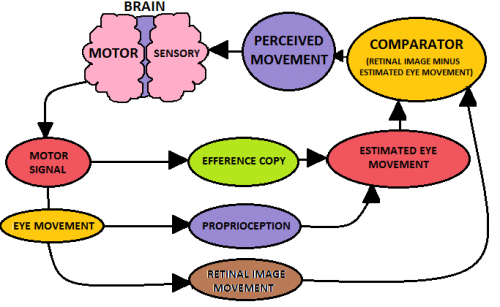
Mechanism for the movement perceived based on associated eye movements
It can therefore be seen that both the magnitude and the speed of a movement from proprioception and efference copy is compared to the magnitude of the image shift on the retina. The two must not match if movement is detected. This can be summarised in the figure below.
The system in the figure above is not completely accurate as both efference copy and proprioception tend to underestimate the eye velocity. This leads to the Albert Fleishi phenomenon:
THE PERCEIVED SPEED OF THE PURSUED TARGET IS ONLY 70% OF THE PERCEIVED SPEED OF THE TARGET WHEN IT IS NOT TRACKED
As there is an underestimation of eye movement, it also means we perceive some movement of the stationary background when we make the smooth pursuit movement. This is known as the Filehne effect.
Motion Detection During Head Movements (Top)
The vestibular system, efference copy of motor movements and the stretch receptors in the neck (muscle proprioception) may all be involved in providing information about head movement. Simultaneous movement of the visual scene rotating around a person who is stationary can actually perceive head motion and can in fact make them feel dizzy or nauseous.
Additionally, the compensatory eye movements made for head movements (the vestibular-ocular reflex) and reduced sensitivity of the visual system during head rotation also aid in maintaining a stable visual percept of the world.
Motion Detection During Body Movements (Top)
The vestibular system, proprioception and efference copy help the brain to distinguish self motion from external motion. This is combined with visual cues which will aid the differentiation. When a person is moving, the visual sensitivity to external motion detection declines. This leads to a greater underestimation of velocity and a distortion of perceived direction of motion.
THIS CONCLUDES THE UNIT ON SELF MOTION AND OPTIC FLOW
